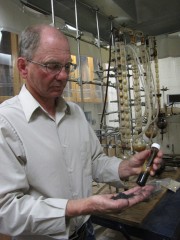South Dakota State University (SDSU) is researching the future, one is which rural landscapes would no longer be dotted with grain elevators but rather with pyrolysis plants that would convert energy crops to fuel or “bio-oil”. This bio-oil would be passed along to other refiniries to produce products such as drop-in fuels or biochemicals while the plants would recycle the syngas produced during the process into an emerging product – biochar. Biochar can be integrated into the soil to help rebuild soil nutrition and sequester carbon.
The USDA has given SDSU a $1 million grant, $200,000 for the next five years, to help scientists design a feedstock production system for optimum energy production of bio-oil while also exploring the possible benefits of biochar.
 “We’re looking at this from a whole system approach, and we’re looking at various components in this whole system,” said SDSU professor Tom Schumacher, the project director “Historically, the distributive nature of crop production gave rise to a network of grain elevators to separate and coordinate the flow of grain to the processing industry. A network of rail lines added new infrastructure to improve efficiency. For lignocellulosic feedstocks, a corollary to the grain elevator would be a collection point that would be within 10 to 30 miles of production fields.”
“We’re looking at this from a whole system approach, and we’re looking at various components in this whole system,” said SDSU professor Tom Schumacher, the project director “Historically, the distributive nature of crop production gave rise to a network of grain elevators to separate and coordinate the flow of grain to the processing industry. A network of rail lines added new infrastructure to improve efficiency. For lignocellulosic feedstocks, a corollary to the grain elevator would be a collection point that would be within 10 to 30 miles of production fields.”
The purpose of the collection points is to receive, sort, pre-process or process feedstocks using pyrolysis. Pyrolysis uses high temperatures in the absence of oxygen to break down organic materials. This technology produces both a bio-oil as well as syngas that can be used to fuel the plant, and biochar. The biochar would be tested in fields around the plant to see how it performs in repairing soil health and as a carbon capture technology.
More specifically, the SDSU study will use a technique called microwave pyrolysis that heats the feedstock by exciting the individual molecules, making it very accurate and easy to control. They will then study how the biochar performs when varying the pyrolysis processing parameters. The feedstocks that will be tested include corn stover, switchgrass and wood biomass.
“There’s a lot that’s unknown about specific types of biochar,” said Schumacher. “There is no single characteristic that can be used to evaluate the effectiveness of biochars. Biochar’s pH and other characteristics can vary widely depending on what feedstock and process was used to produce it. That could make biochar beneficial to the environment, neutral, or possibly even harmful, depending on its characteristics.”

